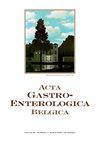奥美沙坦致全胃肠道肠病1例。
IF 1.3
4区 医学
Q4 GASTROENTEROLOGY & HEPATOLOGY
引用次数: 2
摘要
本文章由计算机程序翻译,如有差异,请以英文原文为准。
Olmesartan induced enteropathy affecting the entire gastrointestinal tract: a case report.
Olmesartan, a well-known and powerful antihypertensive drug, was first described to cause enteropathy in 2012. A possible mechanism may be inhibition of the intestinal immune suppressive effect of transforming growth factor-beta (TGF-β), with a consequential increase of intestinal T-cell inflammation. We present the case of a 60-year-old woman who developed large volume, watery diarrhoea with 8kg weight loss only two weeks after starting olmesartan 20mg daily with a secondary mild acute kidney insufficiency and hypokalaemia. Coeliac serology was negative. Endoscopy revealed no macroscopic lesions. Histology showed increased gastric, duodenal, ileal and colonic intraepithelial lymphocytes with partial duodenal villous atrophy, hence affecting the entire gastrointestinal tract. After cessation of olmesartan, symptoms improved within a week; therefore a diagnosis of olmesartan induced enteropathy was made. Extra immunohistochemical stains to further investigate the underlying pathophysiology were inconclusive.
求助全文
通过发布文献求助,成功后即可免费获取论文全文。
去求助
来源期刊

Acta gastro-enterologica Belgica
Medicine-Gastroenterology
CiteScore
2.30
自引率
20.00%
发文量
78
期刊介绍:
The Journal Acta Gastro-Enterologica Belgica principally publishes peer-reviewed original manuscripts, reviews, letters to editors, book reviews and guidelines in the field of clinical Gastroenterology and Hepatology, including digestive oncology, digestive pathology, as well as nutrition. Pure animal or in vitro work will not be considered for publication in the Journal. Translational research papers (including sections of animal or in vitro work) are considered by the Journal if they have a clear relationship to or relevance for clinical hepato-gastroenterology (screening, disease mechanisms and/or new therapies). Case reports and clinical images will be accepted if they represent an important contribution to the description, the pathogenesis or the treatment of a specific gastroenterology or liver problem. The language of the Journal is English. Papers from any country will be considered for publication. Manuscripts submitted to the Journal should not have been published previously (in English or any other language), nor should they be under consideration for publication elsewhere. Unsolicited papers are peer-reviewed before it is decided whether they should be accepted, rejected, or returned for revision. Manuscripts that do not meet the presentation criteria (as indicated below) will be returned to the authors. Papers that go too far beyond the scope of the journal will be also returned to the authors by the editorial board generally within 2 weeks. The Journal reserves the right to edit the language of papers accepted for publication for clarity and correctness, and to make formal changes to ensure compliance with AGEB’s style. Authors have the opportunity to review such changes in the proofs.
 求助内容:
求助内容: 应助结果提醒方式:
应助结果提醒方式:


